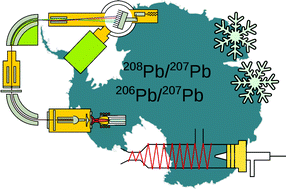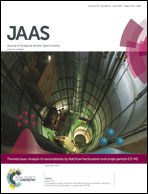Lead isotopic analysis of Antarctic snow using multi-collector ICP-mass spectrometry
Abstract
Reliable determination of Pb isotope ratios in Antarctic snow is challenging because of the low analyte concentration and the low volume of sample typically available. In this work, a combination of a total sample consumption introduction system (the torch-integrated sample introduction system, TISIS) with multi-collector ICP-mass spectrometry (MC-ICP-MS) was used for this purpose. With this instrumental setup, accurate and precise determination of Pb isotope ratios was possible at concentrations as low as 0.5 ng mL−1, while using 0.2 mL of solution only (total amount of Pb: 100 pg). At 10 ng mL−1, the repeatability for the 207Pb/206Pb ratio was 0.16‰ RSD. The concentration range was further extended downwards by using 100-fold analyte element preconcentration via freeze-drying of 20 g of snow. The Pb concentration in procedural blanks was 0.5 ± 0.3 pg g−1, enabling the determination of Pb isotope ratios in snow samples containing down to 5 pg g−1 of Pb. After development and validation, the procedure was applied to snow samples collected at Dome C (East Antarctic Plateau) on a monthly basis during the 2006 and 2010 campaigns. The method developed was able to reveal a seasonal variation in the Pb isotope ratios occurring during 2006 and strong inter-annual variation between the two campaigns.


 Please wait while we load your content...
Please wait while we load your content...